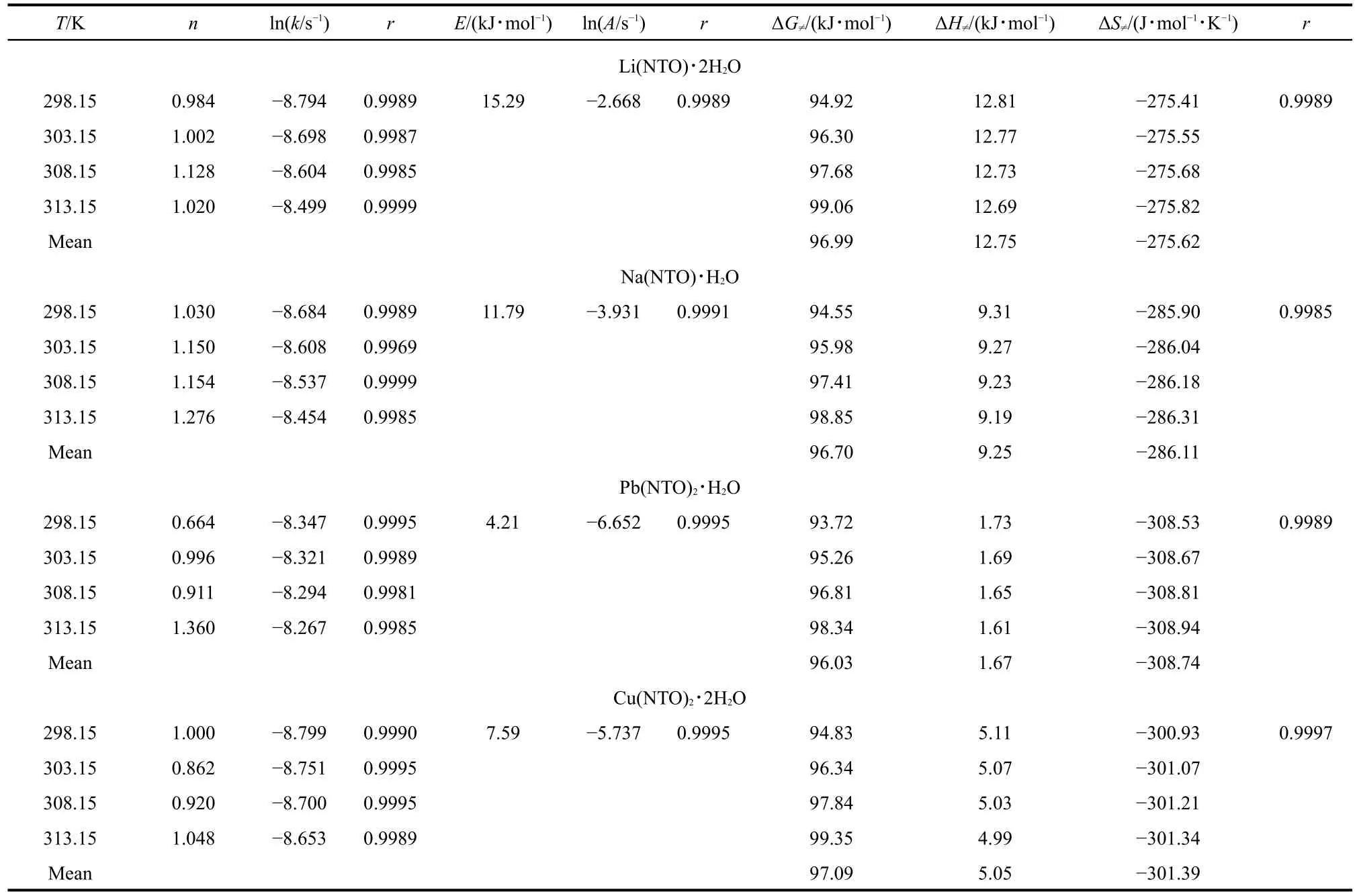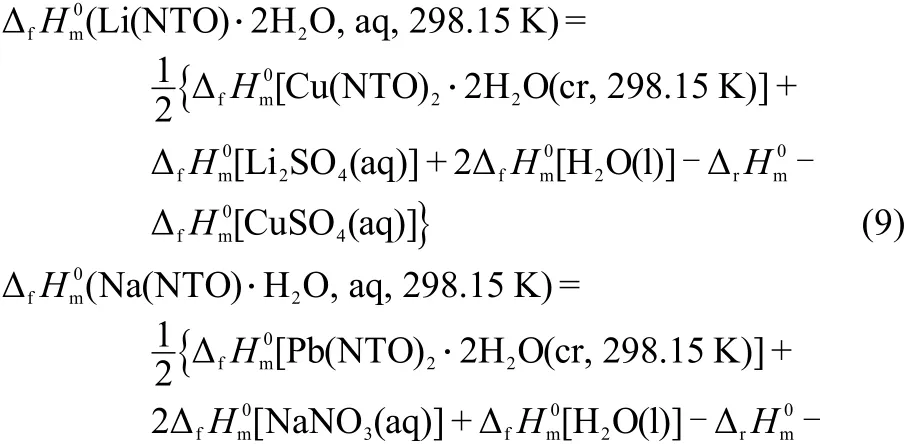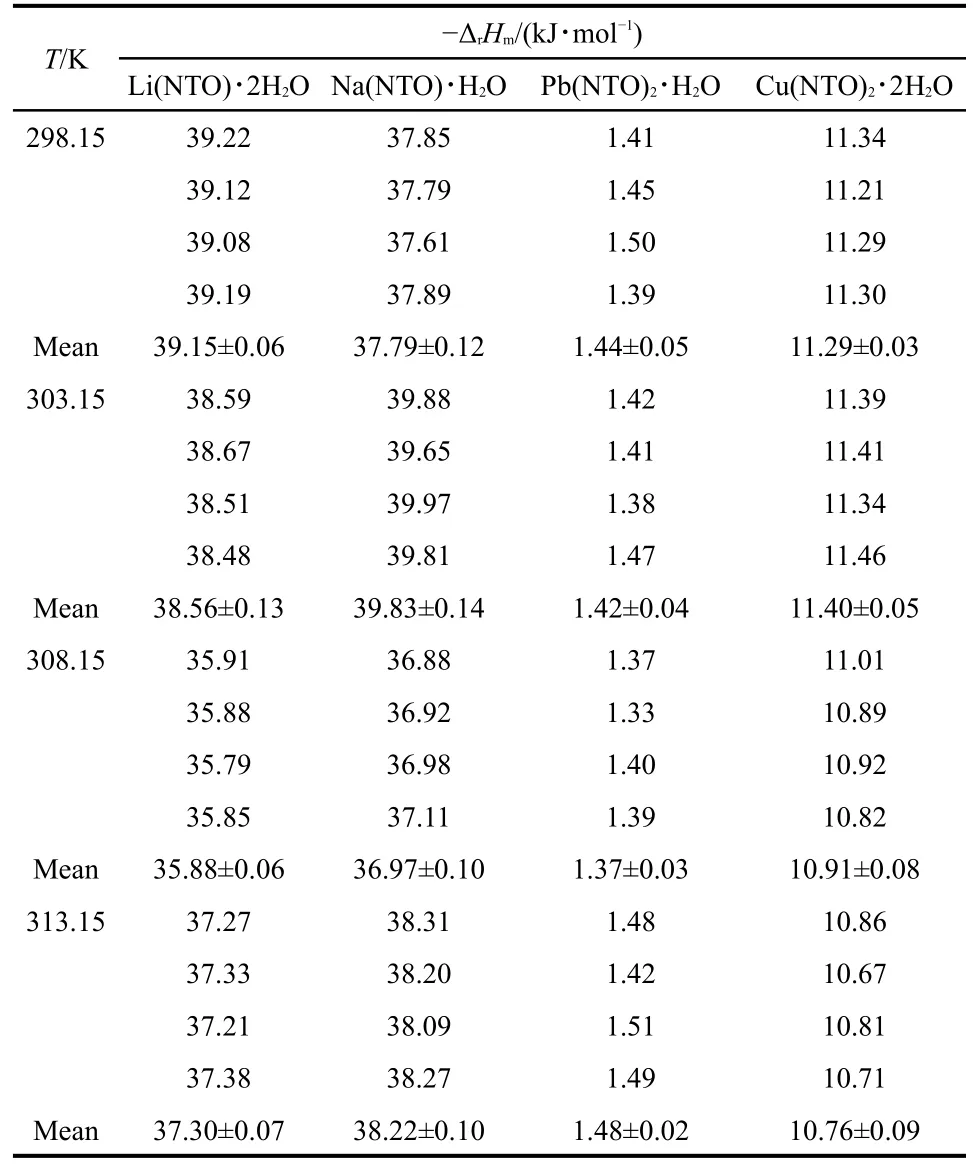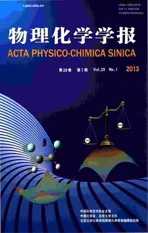3-硝基-1,3,4-三唑-5-酮金属(Li,Na,Pb,Cu)盐的制备反应热动力学
2013-10-18赵凤起高红旭胡荣祖肖立柏姚二岗黄新萍
李 娜 赵凤起 高红旭 胡荣祖 肖立柏 姚二岗 黄新萍 常 佩
(西安近代化学研究所,燃烧与爆炸技术重点实验室,西安 710065)
1 Introduction
3-Nitro-1,2,4-triazol-5-one(NTO)as a high-energy and lowsensitivity explosive is currently receiving increasing attention.1-4Its metal salts are also energetic materials and have been used as energetic combustion catalysts in propellants.5The synthesis,chemical structure,and properties of various salts have been reported.6-15However,the formation thermokinetics of salts of NTO have not been reported.
In this work,the fundamental parameters for the four reactions of preparing metal(Li,Na,Pb,Cu)salts of NTO,includ-ing the reaction rate constant(k),the activation energy(E),the pre-exponential constant(A),the reaction order(n),the activation enthalpy(ΔH≠),the activation entropy(ΔS≠),the activation free energy(ΔG≠),and the enthalpies(ΔHT)were obtained by means of a RD496-2000 Calvet microcalorimeter.These parameters will provide a scientific basis for technological processing of preparing metal(Li,Na,Pb,Cu)salts of NTO.
2 Experimental
2.1 Materials
NTO(A),Li(NTO)·2H2O(B),and Na(NTO)·H2O(C)used in the experiment were prepared by Xi′an Modern Chemistry Research Institute,their purities were more than 99.5%.The water was twice distilled before use.LiOH(D),NaOH(E),sulfate copper(G),and lead nitrate(H)were all analytically pure.They were all dissolved in distilled water.The molarity of solution A was 0.13 mol·L-1.The molarities of solutions B and C were all 0.18 mol·L-1.The molarities of solutions D and E were all 0.15 mol·L-1.The molarities of solutions G and H were all 0.14 mol·L-1.In our experiment,the molar ratios of solution A to solution D,solution A to solution E,and solution A to solution F were all 1:1.The molar ratios of both solution G to solution B and solution H to solution C were 1:2.
2.2 Experimental equipment and conditions
The thermokinetics of the formation reactions of metal(Li,Na,Pb,Cu)salts of NTO were measured by a Calvet microcalorimeter(Mianyang CAEP Thermal Analysis Instrument Company,China),16-19which had a sensitivity of 66.5 μV·mW-1and was equipped with two 15 mL vessels.The microcalorimeter was calibrated by the Joule effect,and the calibration was repeated after each experiment.The precision of enthalpy measurement is 2%.The measurements of the formation reactions were all carried out at 25,30,35,and 40°C.Each process was repeated four times to ensure the precision of the data.20-22VarioE III element analysis equipment from German was employed to detect the contents of C,N,O,and H.Metal contents were measured with a S4 Pioneer X-ray fluorescence spectrometer.
3 Results and discussion
3.1 Element analysis
The elemental analysis results on Li(NTO)·2H2O,Na(NTO)·H2O,Pb(NTO)2·H2O,and Cu(NTO)2·2H2O are listed in Table 1.They are in good agreement with the formulae proposed for these salts.
3.2 Thermokinetic parameters of the formation
reactions of metal(Li,Na,Pb,Cu)salts of NTO The original data are shown in Table 2.These experimental data were put into the thermokinetic equation(1)obtained bythe equation of the reaction of the n th order and the relation between the energy change of a reacting system and the extent of reaction by linear least-squares method.23,24

Table 1 Elemental analysis results on metal salts of NTO

Table 2 Thermokinetic data of formation reaction for metal salts of NTO*

continued Table 2

where HTis the total reaction heat;Htis the reaction heat in a certain time;d H/d t is the exothermic rate at time t;k is the rate constant of prepared reaction;n is the reaction order.
The values of k and n obtained by Eq.(1),the values of E and A obtained by Eq.(2),the value of ΔG≠obtained by Eq.(3),and the values of ΔH≠and ΔS≠obtained by Eq.(4)are all listed in Table 3.

where R is the gas constant(8.314 J·mol-1·K-1);T the absolute temperature;N the Avogadro number(6.024×1023mol-1);h Planck′s constant(6.626×10-34J·s-1);kBthe Boltzmann′s constant(1.3807×10-23J·K-1).
The formation reactions of Li,Na,and Cu salts of NTO were exothermic ones,but the formation reaction of preparing Pb salt of NTO was an endothermic one.The results in Tables 2 and 3 clearly indicated that the higher the temperature of the four reactions,the faster the rate of reactions and the title reactions were of the first order.
The values of E and A for the formation reaction were 15.29 kJ·mol-1and 0.07 s-1for Li(NTO)·2H2O;11.79 kJ·mol-1and 0.02 s-1for Na(NTO)·H2O;4.21 kJ·mol-1and 10-2.89s-1for Pb(NTO)2·H2O;7.59 kJ·mol-1and 10-2.49s-1for Cu(NTO)2·2H2O.
The meanvalues of ΔH≠,ΔS≠,and ΔG≠for the formation reactions of metal salts of NTO in the temperature range 25-40°C are 12.75 kJ·mol-1,-275.62 J·mol-1·K-1,and 96.99 kJ·mol-1for Li(NTO)·2H2O;9.25 kJ·mol-1,-286.11 J·mol-1·K-1,and 96.70 kJ·mol-1for Na(NTO)·H2O;1.67 kJ·mol-1,-308.74 J·mol-1·K-1,and 96.03 kJ·mol-1for Pb(NTO)2·H2O;5.05 kJ·mol-1,-301.39 J·mol-1·K-1,and 97.09 kJ·mol-1for Cu(NTO)2·2H2O.
The values of k,E,and A of the title reactions were very low and the value of ΔS≠was high.These facts showed that the title reactions easily took place in the temperature range 25-40°C.
3.3 Enthalpies of formation reactions for metal salts of NTO
The enthalpies of formation reactions for metal salts of NTOare listed in Table 4.From Table 4,one can see that the values of ΔrHmfor metal salts of NTO are close at different temperatures.

Table 3 Values of n,ln k,ln A,E,ΔG≠,ΔH≠,and ΔS≠of formation reaction of metal salts of NTO
3.4 Calculation of(Li(NTO)·2H2O,aq,298.15 K)and (Na(NTO)·H2O,aq,298.15 K)
The formation reactions of alkali metal(Li and Na)salts of NTO could be represented as follows:

The following Eqs.(7)and(8)could represent the formation reactions of metal(Pb and Cu)salts of NTO:

According to Hess′law,the standard enthalpies of formation of Li(NTO)·2H2O(aq),(Li(NTO)·2H2O,aq,298.15 K)and the standard enthalpies of formation of Na(NTO)·H2O(aq),(Na(NTO)·H O,aq,298.15 K)were calculated through2Eqs.(9)and(10):


Table 4 Enthalpies of formation reactions for metal salts of NTO*

The following values are obtained:

4 Conclusions
(1)On the basis of experimental and calculated results,the reaction rates of the formation of Li(NTO)·2H2O,Na(NTO)·H2O,Pb(NTO)2·H2O,and Cu(NTO)2·2H2O in the studied temperature range were found to be of the first order.The formation reactions of Li,Na,and Cu salts of NTO were exothermic,but the reaction of preparing Pb salt of NTO was endothermic.
(2)The enthalpies of reaction at 298.15,303.15,308.15,and 313.15 K were-39.12,-38.59,-35.88,and-37.27 kJ·mol-1for Li(NTO)·2H2O;-37.79,-39.88,-36.98,and-38.20 kJ·mol-1for Na(NTO)·H2O;1.45,1.42,1.37,and 1.49 kJ·mol-1for Pb(NTO)2·H2O;-11.29,-11.39,-10.92,and-10.71 kJ·mol-1for Cu(NTO)2·2H2O.
(3)The activation energies of the formation reactions of Li(NTO)·2H2O,Na(NTO)·H2O,Pb(NTO)2·H2O,and Cu(NTO)2·2H2O in the temperature range 25-40°C were very low;and the enthalpies of the formation reactions of Li(NTO)·2H2O,Na(NTO)·H2O,Pb(NTO)2·H2O,and Cu(NTO)2·2H2O in our studied temperature range were low.The title reactions easily took place in the temperature range 25-40°C.
(4)Δf(Li(NTO)·2H2O,aq,298.15 K)=-(937.08±5.40)kJ·mol-1, Δf(Na(NTO)·H2O,aq,298.15 K)=-(464.74±5.90)kJ·mol-1.
(1)Zhao,F.Q.;Hu,R.Z.;Xu,S.Y.Chin.J.Explos.Propell.2008,31,18.[赵凤起,胡荣祖,徐司雨.火炸药学报,2008,31,18.]
(2)Sinditskii,V.P.;Smirnov,S.P.;Egorshev,V.Y.J.P ropell.Explos.Pyrotech.2007,32,277.
(3)Trzcinski,W.A.;Szymanczyk,L.J.Energ.Mater.2006,23,151.
(4)Lee,J.S.;Jaw,K.S.J.Therm.A nal.Calorim.2006,85,463.doi:10.1007/s10973-005-7325-0
(5)Fan,X.Z.;Li,J.Z.;Zhang,L.Y.;Wang,B.Z.;Liu,X.G.Chin.J.Energ.Mater.2007,15,316.[樊学忠,李吉祯,张腊莹,王伯周,刘小刚.含能材料,2007,15,316.]
(6)Hu,R.Z.;Meng,Z.H.;Kang,B.Thermochim.Acta 1996,275,159.doi:10.1016/0040-6031(95)02680-0
(7)Song,J.R.;Hu,R.Z.;Li,F.P.Chinese Science Bulletin 1996,41,1806.
(8)Kulkarni,P.B.;Purandare,G.N.;Nair,J.K.;Talawar,M.B.;Mukundan,T.;Asthana,S.N.J.Hazard.Mater.2005,119,53.doi:10.1016/j.jhazmat.2004.12.014
(9)Ma,H.X.;Song,J.R.;Hu,R.Z.Thermochim.Acta 2002,389,43.doi:10.1016/S0040-6031(02)00015-1
(10)Xie,Y.;Hu,R.Z.;Zhang,T.L.J.Therm.Anal.1993,39,41.doi:10.1007/BF02235445
(11)Singh,G.;Felix,S.P.J.Mol.Struct.2003,649,71.doi:10.1016/S0022-2860(02)00717-2
(12)Zhang,T.L.;Hu,R.Z.;Li,F.P.;Chen,L.;Yu,K.B.Chinese S cience Bulletin 1993,38,1350.
(13)Zhang,T.L.;Hu,R.Z.;Li,F.P.Chin.J.E nerg.Mater.1993,1,1.
(14)Yi,J.H.;Zhao,F.Q.;Xu,S.Y.;Gao,H.X.;Hu,R.Z.;Hao,H.X.;Pei,Q.;Gao,Y.Acta Phys.-Chim.Sin.2007,23,1316.[仪建华,赵凤起,徐司雨,高红旭,胡荣祖,郝海霞,裴 庆,高 茵.物理化学学报,2007,23,1316.]doi:10.1016/S1872-1508(07)60065-5
(15)Zhao,F.Q.;Zhang,H.;An,T.;Zhang,X.H.;Yi,J.H.;Xu,S.Y.;Wang,Y.L.A cta Phys.-Ch im.Sin.2013,29,777.[赵凤起,张 衡,安 亭,张晓宏,仪建华,徐司雨,汪营磊.物理化学学报,2013,29,777.]doi:10.3866/PKU.WHXB20130111
(16)Zhao,F.Q.;Xue,L.;Xing,X.L.;Hu,R.Z.;Gao,H.X.;Yi,J.H.;Xu,S.Y.;Pei,Q.Sci.China Ch em.2011,54,463.
(17)Xue,L.;Zhao,F.Q.;Xing,X.L.;Gao,H.X.;Xu,S.Y.;Hu,R.Z.Acta P hys.-Chim.Sin.2009,25,2414.[薛 亮,赵凤起,邢晓玲,高红旭,徐司雨,胡荣祖.物理化学学报,2009,25,2414.]doi:10.3866/PKU.WHXB20091129
(18)Xing,X.L.;Zhao,F.Q.;Yi,J.H.;Gao,H.X.;Xu,S.Y.;Pei,Q.;Hao,H.X.;Hu,R.Z.J.Therm.Anal.Calorim.2010,99,704.
(19)Xing,X.L.;Xue,L.;Zhao,F.Q.;Gao,H.X.;Pei,Q.;Hu,R.Z.Chin.J.Chem.2010,28,1370.
(20)Zhao,F.Q.;Hu,R.Z.;Zhang,H.;Gao,H.X.;Zhao,H.A.;Ma,H.X.Chem.Res.Chin.Univ.2010,26,829.
(21)Xue,L.;Zhao,F.Q.;Xing,X.L.;Gao,H.X.;Hu,R.Z.,T hermoch im.Acta 2009,32,54.
(22)Xiao,L.B.;Xing,X.L.;Fan,X.Z.;Zhao,F.Q.;Zhou,Z.M.;Huang,H.F.;An,T.;Hao,H.X.;Pei,Q.J.Therm.Anal.Calorim.2012,110,1431.doi:10.1007/s10973-011-2036-1
(23)Xiao,L.B.;Zhao,F.Q.;Xing,X.L.;Huang,H.F.;Zhou,Z.M.;An,T.;Tan,Y.Thermochim.Acta 2012,546,138.doi:10.1016/j.tca.2012.07.003
(24)Hu,R.Z.;Gao,S.L.;Zhao,F.Q.;Zhang,T.L.;Zhang,J.J.T hermal Analysis Kinetics,2nd ed.;Science Press:Beijing,2008.
(26)Weast,R.C.C RC Handbook of Chemistry and Physics,70th ed.;CRC Press Inc.:Florida,USA,1989-1990;pp 73-85.
